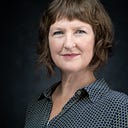The Regenerative Flip
I’ve joined the course, The Power of Place: Regenerative Place-making for Systemic Changemakers. It’s a 12 week learning journey, led by Really Regenerative. See blogposts here by Jenny Andersson, who founded this organisation. I’m doing this course as a cohort, with three others from Climate Museum UK, so we’re learning together. We’re a distributed museum, which means that rather than having one central hub (e.g. a building) we are a growing collective of practitioners curating and gathering responses to the Earth crisis in our localities, working with community and cultural partners. So, the learning we hope to develop through doing this course, that we will share more widely, is about how we work in place with people for regenerative change. Personally, I’m moving from London to Norwich, so I have a shifting notion of what my place is. Or rather, as I’m returning home to my county of Norfolk, the bioregion of the Norfolk Broads, there’s a circular motion and a potential re-learning. A grounding.
I’ve always been very heady in my work, moving up beyond the practical level of any activity or issue to interpret it in more general or theoretical terms. If I try a task, such as planting a tree, it’s because it fits into a symbolic and systemic pattern. I tend not to make a sustained practice of any particular practical task — apart from the very domestic basics. This is perhaps a limiting belief about myself — that I can’t take practical action very well. And I replicate this limiting belief to the bigger, communal issues — feeling that we can’t take effective practical action, quickly enough. I want to get over this, and I want ‘us’ to get over this.
But, I do love to explore the big picture, and I feel that raising awareness of interconnected emergent issues is always helpful in any situation.
Jenny shared this model that was developed from the Interconnectedness of World Problems Map developed by Fritjof Capra based on Plan B 3.0 by Lester Brown. See the screenshot below.
In the course platform, I wondered how war fits into this model, and also whether there were mindsets at a higher level than the belief in unlimited growth powering this model.
So I sketched another model, to try to think about the flow from what I’ve called ‘human exceptionalism’ (which might be called the ‘story of separation’) through to its symptoms — including environmental breakdown and war. It makes a pretty picture from what is in reality an absolute mess, a horrendous stewpot of suffering. The Capra map above shows a cycling back, with the unravelling of civilisation feeding back into the urge to generate more growth, more profit, and to extract more resources. And, this is essentially what is happening — with an escalation of land-grabbing, militarised conflict and imperialistic nationalism, and more support for populist, strongmen leaders all over the world.
And…just to demonstrate the need for flipping our thinking, here’s a flipped version.
The point of my model is to think about how we might lever change at every point of this flow of descent into degenerative collapse. How might people flip the system to a more regenerative culture, and to more beneficial situations for people and other species? Or, how might we tap into the existing biocentric intelligence, the regenerative flow, to make this dominate our systems of exchange, consumption and inter-relating?
I want to collect lots of practical ideas for this flipping, so a week ago, I created this open spreadsheet and invited people on my social media to add ideas to each category. Last week my Twitter feed was going crazy because I reunited a family with an old photo album, with thousands of likes and comments, leading to 12 media invitations. While I was very happy about the response to my small act of kindness, and have already made a friend in Harriet who I contacted out of the blue, I was also struck by the contrast in attention. My post inviting people to share ideas for regenerative flipping received one like, and no ideas. It wasn’t popular. Thinking hard about ways to change big systems is difficult. People like simple and concrete ideas, and emotional stories that make them feel good, especially in these times of trouble. And this is how populism works, and how social media enables it.
Last week I was speaking in a really interesting event about populist politics and museums. I took some of the features of this degenerative system and considered how populist politics uses media or culture to exacerbate these features. See below.
In my talk, I explored the role of museums to expose and challenge these mechanisms. It seems to me that the core problem we Regenerative Culture leaders face is not the lack of ideas for practical actions that will flip our culture, but the power of extractive populism that overwhelms these practices. For every story about solar power there will be a hundred about the hypocrisy of environmentalists. For every act of kindness there will be a missile fired. But still, we have to understand how this has come to be, how this works, and how we can overcome it. This doesn’t mean we have to be populist, or respond to markets and trends, but we do need to understand people’s emotions and why they respond to feel-good messages that play on their fears.
If you hear me on mainstream media (e.g. 23rd April on BBC Radio 4 Saturday Live) talking about an act of kindness to return a photo album, please know that I am really talking about a thousand acts of planetary kindness that will counteract this degenerative power.
See more on how you can support the Regenerative Culture leadership that I do with others.
